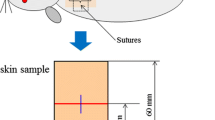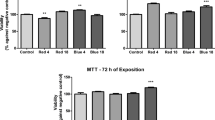Abstract
Collagen I is not only responsible for maintaining the integrity of most tissues due to its mechanical properties, but also for its active participation in the functionality of tissues because of its interaction with cells present in the extracellular matrix. The synthesis of collagen begins with tissue injury and remains until the end of the healing process. The use of non-coherent light for healing processes is still understudied. This procedure stands out as a biostimulation method for tissue repair, which increases local circulation, cell proliferation, and collagen synthesis. This study sought to quantify collagen I in the healing process after the treatment of wounds with the light-emitting diode (LED) treatment. The histologic analysis with tissue samples stained with picrosirius red showed a statistical difference between the positive controls, LED 627 and LED 945 nm groups; the group treated with LED 627 nm showed a predominance of mature collagen. The immunohistochemical analysis showed a statistically significant high concentration of collagen I in the LED 945 nm group. The irradiation of wounds with the higher wavelength (945 nm) used in the study produced the best activity of collagen I formation in experimental model.




Similar content being viewed by others
References
Adiguzel E, Ahmad PJ, Franco C, Bendeck MP (2009) Collagens in the progression and complications of atherosclerosis. Vasc Med 14:73–89
Cretu A, Brooks PC (2007) Impact of the non-cellular tumor microenvironment on metastasis: Potential therapeutic and imaging opportunities. J Cell Physiol 213:391–402
Cremer MA, Rosloniec EF, Kang A (1998) The cartilage collagens: a review of their structure, organization, and role in the pathogenesis of experimental arthritis in animals and in human rheumatic disease. J Mol Med 76:275–288
Shoulders MD, Raines RT (2009) Collagen structure and stability. Annu Rev Biochem 78:929–958
Gelse K, Poschl E, Aigner T (2003) Collagens— Structure, function, and biosynthesis. Adv Drug Del Rev 55:1531–1546
Artuc M, Hermes B, Steckelings UM, Grutzkau A, Henz BM (1999) Mast cells and their mediators in cutaneous wound healing—Active participants or innocent bystanders? Exp Dermatol 8:1–16
Noli C, Miolo A (2001) The mast cell in wound healing. Vet Dermatol 12:303–313
Zhmakin AI (2011) Enhancement of light extraction from light emitting diodes. Phys Rep 498:189–241
Zanin IC, Lobo MM, Rodrigues LK, Pimenta LA, Hofling JF, Goncalves RB (2006) Photosensitization of in vitro biofilms by toluidine blue O combined with a light-emitting diode. Eur J Oral Sci 114:64–69
Sinno H, Malhotra M, Lutfy J et al (2012) The effect of topical collagen treatment on wound breaking strength and scar comesis in rats. Can J Plast Surg 20(3):181–185
Barbosa CJ, Teles C, Moreira LM, Damião AJ, de Lima CJ (2012) A novel opto-mechanical system constituted by LEDs to employment in photobiostimulation: Clinical application in optical therapy. Spectroscopy 27:9–18
Havem M, Betz CS, Leunig A, Sroka R (2014) Diode laser-induced tissue effects: In Vitro tissue model STUDY and in vivo evaluation of wound healing following non-contact application. Lasers Surg Med 46:449–455
Araújo KS (2009) Efeito da terapia com LED operando em baixa potência sobre a reparação óssea de ratos – Análise por espectroscopia Raman. Dissertação de mestrado no programa de pós-graduação em Bioengenharia, UNIVAP, 57 p
Mendez T, Pinheiro A, Pacheco M et al (2004) Dose and wavelength light have influence on the repair of cutaneous wounds. J Clin Laser Med Surg 22(1):19–25
Pugliese LS, Medrado AP, Reis SR, Andrade Zde A (2003) The influence of low-level laser therapy on biomodulation of collagen and elastic fibers. Pesqui Odontol Bras 17:307–313
Paraguassú GM, Guarda MG, Xavier FCA et al (2014) Effects of LED phototherapy on relative wound contraction and reepitheliazation during tissue repair in hypothyroid rats: Morfometric and histological study. Lasers Med Sci 29:773–779
Min PK, Goo BL (2013) 830 nm light-emitting diode low level light therapy (LED-LLLT) enhances wound healing: a preliminary study. Laser Ther 22(1):43–49
Moll I, Roessler M, Brandner JM, Eispert AC, Houdek P, Moll R (2005) Human Merkel cells aspects of cell biology, distribution and functions. Eur J Cell Biol 84:259–271
Author information
Authors and Affiliations
Corresponding author
Rights and permissions
About this article
Cite this article
Kerppers, I.I., de Lima, C.J., Fernandes, A.B. et al. Effect of light-emitting diode (ʎ 627 nm and 945 nm ʎ) treatment on first intention healing: Immunohistochemical analysis. Lasers Med Sci 30, 397–401 (2015). https://doi.org/10.1007/s10103-014-1668-3
Received:
Accepted:
Published:
Issue Date:
DOI: https://doi.org/10.1007/s10103-014-1668-3




